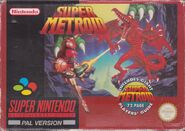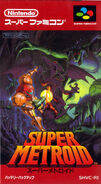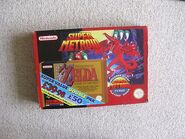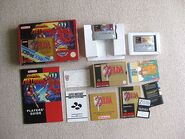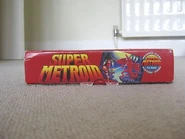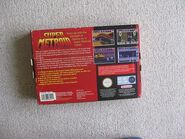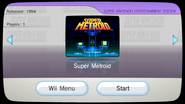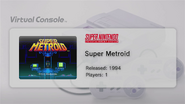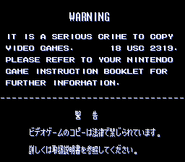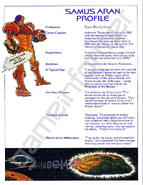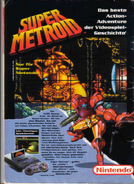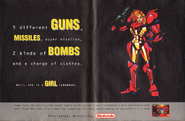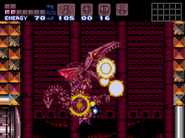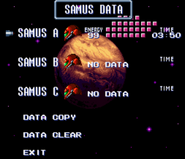| This article is written from the Real Life point of view |
- This article is about the game. For other uses, see Super Metroid (Disambiguation).
Super Metroid (スーパーメトロイド Sūpā Metoroido), also known as Metroid 3, is a video game developed by Nintendo R&D1 and published by Nintendo for the Super Nintendo Entertainment System. Super Metroid is the third installment in the Metroid series. With its 24-megabit cartridge size, it was the largest game available for the console at the time of its release.[2]Super Metroid is a 2D platform video game with action and adventure elements. Game progression revolves around gathering Power-ups that allow Samus Aran to overcome obstacles in order to access new parts of the world. Like most 2D Metroid games, the world has a non-linear design and features many hidden areas, making exploration a central concept of the game.[3] It is considered as one of the greatest video games of all time, and its formula has served as the primary basis for all Metroid games to follow.
Super Metroid was released on the Wii's Virtual Console on August 20, 2007 as part of the "month of Metroid" campaign.[4] It was also added as one of the Masterpiece demos in Super Smash Bros. Brawl and Super Smash Bros. for Wii U, allowing in Brawl 3 minutes of play from 3 different saves.
The game was made available on the Wii U's Virtual Console from May 15, 2013 to June 13, 2013 as part of the Wii U Virtual Console Trial Campaign, which allows for GamePad-only play and customizable controls.[1] Those who own the Wii Virtual Console version of Super Metroid will be able to get the Wii U Virtual Console version for a reduced price.[5]
Plot
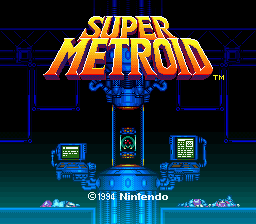
The title screen for Super Metroid.
After exterminating the Metroids on SR388 in Metroid II: Return of Samus, Samus Aran brought the infant Metroid to the Ceres Space Colony, likely staying at the colony while scientists studied the young Metroid. The scientists' findings showed that the powers of Metroids could be harnessed for the benefit of mankind. Leaving the Baby in their care, Samus left Ceres in search of a new bounty to hunt. However, shortly after leaving, Samus picked up a distress call from Ceres and returned to investigate. As Samus explored the space colony, she discovered the bodies of the scientists lying about the room that had held the Baby's capsule in a tube. The tube itself was broken and empty. Continuing her investigation, Samus soon encountered Ridley once again, finding him clutching the Baby's capsule. Samus desperately fought Ridley, but he overpowered her and fled the station carrying the hatchling. At the same time, a Countdown began, leaving Samus a mere 60 seconds to escape before the station's destruction. Samus quickly returned to her gunship and pursued Ridley to the nearby planet Zebes.
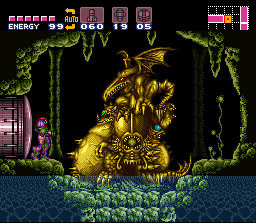
The entrance to Tourian, guarded by the Golden Statues.
Arriving at Zebes, Samus discovered that the Space Pirate base that she had destroyed in her last visit to the planet had been rebuilt during the years in which the events of the Prime series (including Metroid Prime: Hunters) took place. By this time a portion of Crateria, the surface of Zebes, had integrated with Tourian from Metroid (dubbed "Old Tourian"), including Mother Brain's old control chamber, suggesting that these areas were the remains of the Space Pirate base from the original Metroid. Samus set out to locate the infant Metroid and prevent the Space Pirates from gaining use of its powers. As in the previous games, Samus was forced to delve into the planet through its many caverns to hunt down the Space Pirates. This time, however, Samus could only enter Tourian by destroying four bosses: Kraid, the obese lizard who was one of the original guardians of Tourian and whose base makes up a large part of Brinstar; Phantoon, a ghostly entity that controls the Wrecked Ship and reroutes its power supply to Mother Brain; Draygon, a crustacean monster that occupies a submerged Pirate lab in Maridia; and Ridley himself, who controls Norfair from the inside of his own lair.
After defeating all four bosses and discovering the Mochtroids, unsuccessful clones of Metroids, Samus battled her way through Tourian, encountering newly bred Metroids. After destroying everything in her way, she encountered a Metroid far larger than the rest. Before she could attack it, the giant Metroid drained all but one unit of her Power Suit's energy. However, it seemed to recognize Samus; as this huge Metroid was actually the Baby. According to the Super Metroid Nintendo Player's Guide, the huge Metroid is named "Super Metroid".
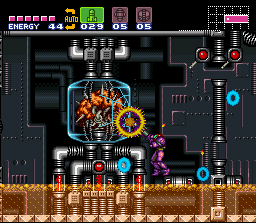
Samus fighting the first form of Mother Brain.
After the Metroid departed, Samus restored her suit's energy and confronted Mother Brain. After Samus destroyed her Control Capsule and inflicted enough damage, Mother Brain attached itself to a giant mechanical body and the battle began again. During the battle, Mother Brain repeatedly used a massive burst of energy from its eye on Samus, leaving her near death and unable to stand. Before the final blow could be inflicted, however, the once-Infant Metroid suddenly attacked Mother Brain, draining its energy until it slumped against the wall, gray and seemingly lifeless. The Baby then attached itself to Samus and began feeding the stolen energy to her while carrying her through the air (as depicted in Metroid: Other M's recreation of the battle in its intro). However, Mother Brain soon recovered and began firing upon the baby, weakening it until it lifted off of Samus. A final shot destroyed the hatchling, leaving its remains to fall upon Samus.
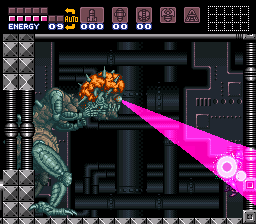
Mother Brain hitting Samus with the Laser Brain Attack.
Pulsating with energy from Mother Brain, Samus now possessed the Hyper Beam. With it, she avenged her fallen "child" and easily destroyed Mother Brain, who fell to the floor and crumbled to dust. This in turn triggered a self-destruct sequence, giving Samus three minutes to escape through the emergency evacuation shaft of the original base. Along the way, Samus rescued three Etecoons and two Dachoras she had encountered earlier in Brinstar. She made it to her gunship just in time and took off, watching the planet crack and explode in a flash of bright light.
The Space Pirates were gone, or so it was hopefully believed, but the universe had lost the possibility of using the Metroids for the good of mankind. Zebes, the home of the Chozo was lost forever, and Samus had fallen into a state of depression over the loss of her baby.
The events of Metroid: Other M followed soon afterward.
Gameplay
Super Metroid's gameplay is very similar to the other Metroid games in the series, though it is better known for its non-linearity. Due to this, Super Metroid is often used for speed runs.
Super Metroid takes place on the large, open-ended planet Zebes. Samus progresses through the planet by finding Power-ups that enable her to access new areas, much like other 2D Metroid titles. For example, finding the Morph Ball allows Samus to obtain the Missiles, and finding them lets her access several more areas.
The game introduced new abilities and concepts, such as combining weapons and the ability for Samus to customize herself -- she can change her suit and enable or disable her abilities at will. She can also perform a "Moon Walk", in reference to Michael Jackson's dance move of the same name, which allows her to walk backwards slowly while charging a shot, or rapidly firing if she does not have the Charge Beam.
Super Metroid is also the first game in the series to implement a map feature to aid the player in navigation. This has since become a staple of the series appering in every subsequent entry to date.
Power-ups/Suit upgrades
Main Article: List of items in Super Metroid
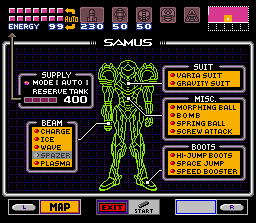
From the inventory screen, the player can enable or disable weapons and other abilities that Samus has gathered by collecting power-ups.
The use of weapons, Power-ups and other suit upgrades in Super Metroid is twofold: to defeat enemies and to overcome obstacles found in the environment.
- Energy Tanks
- Energy tanks can be collected throughout Zebes to increase Samus' maximum energy total.
- Reserve Tanks
- There are also four reserve tanks, each holding up to 100 backup energy units. On auto, Samus will automatically drain the tanks once her main energy supply is drained.
- Beams
- Samus' Arm Cannon, like the rest of her Power Suit, is highly modular and upgradable. Her starting weapon is the Power Beam, which is relatively weak and useless against later enemies and most bosses. There are six upgrades, three are new beam weapons, each more powerful than the last one, and the other three are properties added to the beams:
- Charge Beam: Acquired in Brinstar. This upgrade allows Samus to charge up her beam weapons and release a powerful attack. This lets her damage some enemies that are impervious to simple beam shots.
- Wave Beam: Acquired in Norfair. Allows beam shots to pass through walls.
- Spazer Beam: Acquired in Brinstar. Shoots three parallel yellow laser shots. Has much more power and width than the Power Beam. Cannot be equipped at the same time as the Plasma Beam.
- Plasma Beam: Acquired in Maridia. A green laser that is capable of hitting multiple enemies at a time. Much stronger than the Spazer Beam. Cannot be equipped in conjunction with the Spazer Beam.
- Hyper Beam: Acquired at the end of the game during the fight with Mother Brain. Its energy source is based upon the deadly attack that the Mother Brain nearly defeated Samus with. It is the most powerful beam, and though it cannot be charged, it does have rapid-fire capabilities. Replaces all other beam upgrades in the inventory screen.
- Suits
- At the beginning of the game, Samus' Power Suit is yellow and offers very little environmental protection. Each of the following suit modifications also reduces damage sustained by Samus.
- Varia Suit: Acquired in Brinstar, this upgrade to the Power Suit allows Samus to withstand the extreme temperatures of Norfair and changes the suit to an orange color, as well as offering a slight decrease in damage taken.
- Gravity Suit: Acquired in the Wrecked Ship, this upgrade to the Power Suit enables Samus to move in liquid environments unhindered and changes the suit to a purple color. The Gravity Suit also allows Samus to move through most pools of Lava unharmed.
- Miscellaneous
- These upgrades award Samus with new abilities.
- Morph Ball: This Power-up, acquired in Brinstar, makes its return from the original Metroid. It allows Samus to roll into a ball in order to go through small passageways and to deploy Bombs.
- Bombs: When in Morph Ball mode, Samus' Power Suit can deploy bombs used for destroying obstacles that block Samus' path and attack some enemies.
- Spring Ball: Acquired in Maridia, this Power-up allows Samus to jump while in Morph Ball mode.
- Screw Attack: The Screw Attack is a jumping technique that transforms Samus Spin Jump into a whirling saw blade of energy that can destroy enemies and clear obstacles.
- Boots
- These upgrades deal with Samus' mobility skills.
- High Jump Boots: Acquired in Norfair, these boots nearly double Samus' vertical leap.
- Space Jump: Acquired in Maridia, these boots allow Samus to repeatedly somersault in mid-air.
- Speed Booster: Acquired in Norfair, the Speed Booster allows Samus to accelerate to near super-sonic speeds while running.
- Other items
- A variety of weapons and tools that can be used by Samus.
- Missiles: Missiles are used to open locked doors and to defeat enemies that are invulnerable to regular beams.
- Super Missiles: Super Missiles are similar to ordinary Missiles but carry five times the power. They are capable of opening doors that Missiles cannot, and there are many enemies that cannot be destroyed with any other weapon in Samus' arsenal. The impact of a Super Missile can dislodge enemies crawling on walls and ceilings.
- Power Bombs: Power Bombs are deployed the same way as ordinary bombs, but their explosion is of a much greater magnitude, releasing a giant field of destruction.
- X-Ray Scope: The X-Ray Scope, found in Brinstar, allows Samus to see hidden passageways and destructible blocks.
- Grappling Beam: The Grappling Beam, acquired in Norfair, allows Samus to swing from magnetic blocks and certain enemies on an arc of electricity. The Grappling Beam, while apparently powerless, can actually be used to defeat a number of enemies, especially in Maridia. Draygon can be defeated by using it to transfer deadly amounts of electricity to it through Samus' Power Suit.
Areas
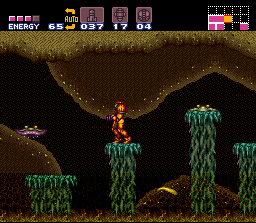
A portion of Maridia.
- Ceres Space Colony
- Ceres Space Colony is where the game begins and the scene of the discovery that the Metroids could be used for the good of galactic society. All of the scientists were killed by Ridley when he came to the colony. The colony was blown to pieces when Samus and Ridley left the station.
- Crateria
- The surface area of planet Zebes. The surface of the planet is plagued by acid rain -- living creatures are therefore mostly found below surface level. This is also where Samus' ship lands.
- Brinstar
- The jungle area of Zebes, teeming with life. The area of Brinstar explored in this game is vastly different from that of the original mission. Kraid's Lair is located in this area.
- Norfair
- It lies deep below the surface and thus requires its visitors to carry sufficient protection from the incredible heat. Ancient Chozo ruins can be found in the deepest parts of Norfair, which is also where Ridley's Lair can be found.
- Wrecked Ship
- A long time ago, astronauts belonging to an ancient civilization crashed on Zebes. This is what remains of their space ship. The ghost Phantoon has shut down the Wrecked Ship, making most of it inaccessible at first. Before the fight, the ship is in total darkness and Coverns will materialize and attack Samus. Due to the location of the Space Pirate Mothership in Metroid: Zero Mission, fans had originally speculated that it was intended to be the Wrecked Ship depicted in Super Metroid. However, Zero Mission director Yoshio Sakamoto has dismissed this possibility, saying that the two ships are separate - during Zero Mission the player passes through an area that appears to be outside the Super Metroid wrecked ship in Crateria while the Mother Ship has not yet landed[6]. Additionally, once players obtain the Power Bomb, a small segment of the Wrecked Ship can be accessed.
- Maridia
- The ocean world of Zebes. Most of Maridia occupies territory that was once part of Brinstar. The area contains an aquatic Pirate laboratory where they have bred a mostly unsuccessful Metroid clone called the Mochtroid. The giant crustacean creature Draygon is the guardian of this area.
- Tourian
- The control center of the Zebesian Space Pirates and Mother Brain. The location has shifted to a more secure area since Metroid/Metroid: Zero Mission.
Enemies
Bosses
- Kraid
- Kraid was a boss in the original NES game, along with Ridley. He is considerably larger than before, taking up the space of two vertical screens. Although many players speculated that Kraid somehow grew since the first game, Metroid: Zero Mission has since retconned Kraid to have a consistent size between games. Outside Kraid's chamber, a seemingly fresh human corpse is found. Although the identity has never been revealed, the body resembles a Galactic Federation Marine.
- Phantoon
- Phantoon is a ghostly flying creature who taps into Mother Brain's brainwaves and feeds off the Wrecked Ship's energy supply. Unlike most bosses which are fought at or near the end of a level, Phantoon must be defeated before the rest of the Wrecked Ship may be explored.
- Draygon
- Draygon is an enormous sea creature that resides in Maridia. Its hard armor-like shell provides it with a great amount of defensive strength and it is guarded by several wall-mounted cannons.
- Ridley
- Ridley, the monster whom Samus fought in the original NES game, makes his comeback as one of the hardest bosses in the game. He is responsible for the bloodbath at Ceres Space Station and the kidnapping of the Metroid hatchling.
- Mother Brain
- The final boss, this entity is a disembodied brain in a tank protected by deadly Rinka laser rings, automated defense cannons, and self-regenerating organic life support conduits. When it is down, a new mechanical body rises out of the floor, allowing Mother Brain to move. After the second defeat, Zebes' final Countdown begins.
Mini-bosses
- Bomb Torizo
- The Bomb Torizo appears to be a simple Chozo statue which possesses the Bombs, until Samus takes the item from it. A Chozo-like creature then bursts out of the statue and attacks using its claws, bombs, and energy waves.
- Spore Spawn
- The Spore Spawn is a native inhabitant of the subterranean jungles of Brinstar. It consists of an entire room of plant biomatter connected to a large, head-like pod which can swing about the room. Spores are constantly released from the ceiling of the room during the battle.
- Crocomire
- This denizen of Norfair is a red, eight-eyed, thick-skinned beast that can tolerate even the hottest temperatures. It is massive, and its primary mode of attack consists of rushing toward Samus in an attempt to push her back into a spiked wall. Just prior to its death, it jumps at Samus for one final attack as a skeleton, but the attempt is in vain as it simply collapses into a pile of bones.
- Botwoon
- Botwoon is a serpent-like creature with a crocodile's head. Its main attack simply consists of rushing between the various burrows in its chamber in wide arcs. It will occasionally reveal only its head from one of the burrows and will shoot energy beams at Samus.
- Golden Torizo
- A much more powerful incarnation of the Bomb Torizo fought in Lower Norfair. It guards the Screw Attack.
Minor Enemies
- Space Pirate
- Space Pirates are the main villains in the game. They can fire beams from their claw-like weapons and climb walls. As the story progresses, they get much stronger and harder to kill. Some can only be killed with a specific weapon.
- Kihunter
- Kihunters are wasp-like allies of the Space Pirates that spit acid and slash with their scythes.
Friends
Not all inhabitants of Zebes are hostile towards Samus. On the planet, Samus may also encounter the following helpful creatures:
- Etecoons
- A trio of small, four-limbed monkey-like creatures that demonstrate the difficult Wall Jump technique with considerable ease. They sing the item collection song when they appear. They are encountered in an area that can only be exited through the use of wall-jumping, Bomb Jumping, or Space Jumping. These creatures are green in Super Metroid, but appear blue in Metroid Fusion and other artwork.
- Dachora
- A green alien that resembles an ostrich. The Dachora demonstrates the Shinespark technique, which is required to escape from the area in which it is found. It has a nest with an egg in Super Metroid, which is later a hatched baby Dachora in Metroid Fusion.
- Tatori and Tatori, Jr.
- Tortoise-like creatures inhabiting Maridia. Samus can safely stand on the mother; the offspring do nothing. Should Samus attack some of the offspring, the mother will attack her in return by spinning rapidly. Samus can utilize this mechanism to reach an Energy Tank suspended above a Grapple Point.
After defeating Mother Brain and starting the self-destruction of Zebes, Samus may choose to save the first two creatures. A flashing metal door appears in Crateria, the one that originally led her to acquire the Morph Ball Bomb. In this chamber the creatures appear to be trapped. Samus can destroy the opposite facing wall so that the aliens may escape. This causes a slight change in the ending cutscene, in which a flash of light can be seen escaping from the planet. This ending is canon, as the creatures show up alive and well in Metroid Fusion.
Reception
At the time of its release, Super Metroid was universally praised. To this day, it remains one of the most popular and critically lauded games not only for the SNES, but in all of gaming history. It has sold 1.4 million units (780,000 in Japan and 460,000 in North America), becoming a Player's Choice. It frequently appears in "best games of all time" lists; Electronic Gaming Monthly has named Super Metroid the best game of all time,[7] and IGN ranked it the third best game of all time in its 2003 "top 100" list, and fourth best game of all time in its most recent 2006 list, with the motivation:
| “ | Hailed as one of the best 2D adventures ever, Nintendo's sci-fi epic still provides one of the most thought out and intriguing gameplay experiences around. Ranging from extensive platform challenges to gigantic boss battles to a comprehensive power-up system, Super Metroid has attained a divine place in the hearts of longtime gamers. Certainly, it stands as something players and developers can idolize for years to come.[8] | ” |
Swedish game publication Super PLAY ranked Super Metroid number 6 in the "top 100" list its March 2003 issue, commenting on its atmosphere:
| “ | The graphics and sound form a wonderful symbiosis, creating an almost tangible atmosphere. Concerning the looks, there is no individual part that sticks out; the game maintains an even, stable, and thoroughly crafted graphical style. The music mostly consists of reserved, dark and mystical melodies that lurk in the background. After a while they consume you, fully immersing you in the Samus role. And the role is indeed an exciting one to play. The pure joy of exploration is on top and constantly makes you thirst for more. | ” |
In a Metroid feature in its December 2002 issue, Super PLAY also noted the game's care to detail:
| “ | Super Metroid remains one of the most well made adventures ever produced. Every detail, from the echoing ice shafts to the statue that shifts color to illustrate which of the game's four bosses have been defeated, is indicative of an almost manic dedication among the developers at R&D1. | ” |
Legacy
Super Metroid served as a formula for subsequent 2D games in the Metroid series, as it refined and provided a definitive version of concepts introduced in the first two Metroid games.
The two-dimensional Castlevania games beginning with Castlevania: Symphony of the Night on the PlayStation/Sega Saturn and continuing on the Game Boy Advance and Nintendo DS borrow elements from Super Metroid, such as the "retraversal" style of gameplay involving items that give new abilities to access new areas, as well as the style of map. This has led to the creation of the terms "Castleroid" and "Metroidvania" when describing similar action-adventure games.
Speed Running
Super Metroid's open-ended gameplay style has made it a popular choice for speed runs. Due to the non-forced storyline and optional powerups, many players compete to see who can complete the game fastest, or with the fewest items, or both. This has caused Super Metroid to be a major contributor to the speedrun phenomenon, and one of the most popular games for both assisted and unassisted speedruns. Most speed runs are available from the Internet Archive.
Tricks
Records
- Best time: 0:32 [1] by Satoru 'Hotarubi' Suzuki
- Best 100% time: 0:48 by Christopher 'Behemoth' Hill
- NBMB: 72% by Red Scarlet
- Tool-assisted, 100%: 0:36 by Cpadolf
- Tool-assisted, speed: 0:22 by Saturn
- Low %: 14% in 1:18 by Smokey
- Glitchless 100%: 1:05 by Smokey
- Tool-assisted, low %: 14% in 0:27 in by Saturn
- Tool-assisted "Reverse Boss Order": 0:26 by Saturn
Older runs
- 100% in 0:55 by juliano_did
- 100% in 0:56 by Smokey
- 100% in 0:58 by Smokey
- 100% in 1:00 by Red Scarlet
Trivia
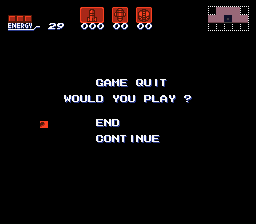
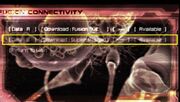
Metroid Prime
- Super Metroid was almost canceled three times during its development due to the fact that it was the largest game ever created up to that point.
- Super Metroid is the only 2D Metroid game in which the Grappling Beam is used.
- The game's cartridge appears in the Super Nostalgic Entertainment System microgame in WarioWare: Smooth Moves.
- The music that plays at the end of the game, after the epilogue, is also apparently reused in Metroid Prime 2: Echoes at the beginning of fights with special enemies in Agon Wastes.
- Super Metroid is the first Metroid game to render Samus' visor as transparent (during the prologue).
- Danny Richardson's Metroid Prime menu design originally had Super Metroid instead of Metroid. Retro Studios discussed having Super Metroid as an unlockable extra in Metroid Prime 2: Echoes, but it did not make it in due to time constraints. [2]
- Certain aspects of the game are similar to the film Alien 3. Both depict a bond between the female protagonist (Ellen Ripley/Samus Aran) and an alien specimen.
- Entering the Golden Torizo room while pressing all of the controller's face buttons will give Samus all of the game's items except for the Screw Attack (which is in the following room), 700 Energy, 300 Reserve Energy, 100 Missiles, 20 Super Missiles, and 20 Power Bombs. [3]
- Through a Game Genie, (code 8E67-C0DF) an options menu not used in the final game is available. The options text reads:
- GAME QUIT
- WOULD YOU PLAY?
- END
- CONTINUE
- GAME QUIT
- If this code is used on an emulator, such as the ZSNES, it will cause several sprite glitches and slow-downs. Worthy of note is that when in this mode, the Energy, Missile Ammo, Super Missile Ammo and Power Bomb Ammo are all in red, with a slightly different font than in the final game.
- When working on the concept for the next Metroid game after Metroid Fusion, one developer suggested porting Super Metroid to the Game Boy Advance. However, Yoshio Sakamoto wanted to port Metroid instead, thus creating Metroid: Zero Mission. [4]
- Many of the game's sound effects are similar or identical to those used in the popular space opera series Star Trek: Deep Space 9.
- Some kaiju roars from the Godzilla movies can be heard in this game. Crocomire lets out a Titanosaurus (an aquatic dinosaur from Terror of Mechagodzilla) roar while he is being killed by lava (the same roar is used again when Phantoon is hit). Also, Draygon uses the roar from Anguirus (a giant mutated ankylosaur who is an ally of Godzilla) occasionally.
Gallery
- For concept art, see Super Metroid's Gallery.
See Also
References
- ^ a b Green, Andy (2013-01-26). Nintendo Reveals Specific Dates For Wii U Virtual Console Trial Campaign. Nintendo Life. Retrieved on 2013-02-03.
- ^ The Greatest 100 Games Ever: 40-21. PAL Gaming Network. Retrieved on 2006-09-03.
- ^ Allen Varney (2006-04-04). Metroid Primed. The Escapist. Retrieved on 2007-08-21.
- ^ Super Metroid for Download. IGN (2007-08-20). Retrieved on 2007-08-21.
- ^ Goldfarb, Andrew. "Wii U Virtual Console, OS Upgrades Announced", IGN, 2013-01-23. Retrieved on 2013-01-23.
- ^ Question 2 of the "Metroid FAQ", Metroid Zero Mission Official Site, accessed September 14, 2005.
- ^ 100 Games Of All Time. gamers.com. Retrieved on 2006-09-03.
- ^ 100 Games Of All Time. IGN. Retrieved on 2007-07-15.



